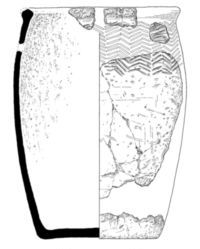On the beach: new discoveries at Harlyn Bay, Cornwall
Andy M. Jones, Jane Marley, Henrietta Quinnell, Steve Hartgroves, 2010. https://doi.org/10.5284/1000384. How to cite using this DOI
Data copyright © Dr Andy M. Jones, Jane Marley, Henrietta Quinnell, Steve Hartgroves unless otherwise stated
This work is licensed under the ADS Terms of Use and Access.
Primary contact
Henrietta
Quinnell
39D Polsloe Road
Exeter
EX1 2DN
England
Resource identifiers
- ADS Collection: 1018
- DOI:https://doi.org/10.5284/1000384
- How to cite using this DOI
Introduction

In 1990 a stone covered pit containing a Trevisker Ware vessel was eroding from the cliffs at Harlyn Bay and excavated. The vessel contained cremated bone from several individuals with some animal bone, quartz pebbles and a small bronze pendant. A radiocarbon date on the cremated bone fell between 2120-1880 cal BC and is a valuable addition to the small number of securely dated Early Bronze Age burials in Cornwall with a metalwork association. This early date also makes a major contribution to the debate on the sequence of Trevisker Ware as the vessel, of gabbroic clay, has a band of incised chevron decoration, thus demonstrating that incised decoration as well as cord impressed could occur at an early date. Lipid residue analysis showed traces of ruminant dairy fat.






